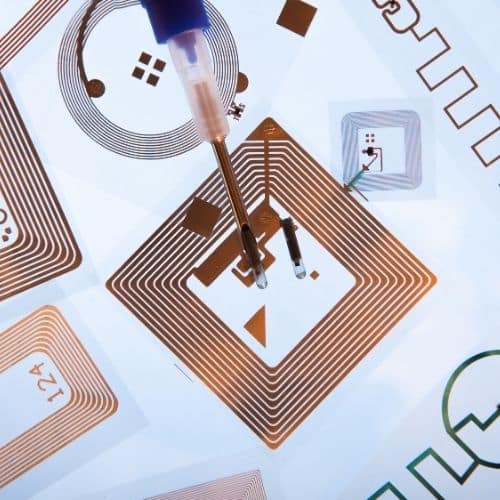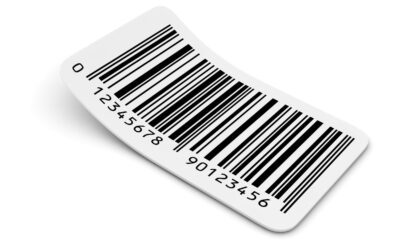QR vs. RFID, which is better?
The answer to an age old technological question: QR tags or RFID tags? Which one is more helpful for my asset management? Which one would come out on top? Which one is right for me? The answer is quite simple: it depends. Yet, this only raises more questions. So, which one should you be using? Read on to find out.

The Debate
What is the difference between QR code asset tags and RFID asset tags? In the debate of QR vs RFID, both of them have a similar purpose and usage, but if you have a scanner nearby, an “active” RFID tag will constantly transmit information (more on the different RFID tag types later), whereas a QR code needs to be rescanned each time individually and with line of sight.
Although this may suggest there is an obvious winner in the QR vs RFID debate, that’s not necessarily the case. While RFID tags have increased functionality and connectivity, QR tags are often much more practical. They’re also cheaper as they’re easier to print.
There is a lot to take into account before you make a decision on which to invest more of your time and money. You wouldn’t want to spend a fortune on RFID tags and scanners and then use them in the same way you’d be using QR tags or even cheaper RFID tags.
QR Benefits

The first benefit of the QR vs RFID discussion is the effectiveness of the QR codes. All you need to scan one is a smartphone and some software, and they’re cheap and easy to use and generate. The time you would be spending configuring an RFID tag (unless you use itemit, in which case your RFID tags are configured for you) could be used simply shipping around your assets, as all it takes is thirty seconds to stick on a tag, scan the tag, and add your asset to your fixed asset register.
As they’re so easy to generate, they’re also incredibly cheap. QR codes are a good alternative to RFID. You won’t have to worry as much about time constraints or budgeting because before you order tags, you’ll probably own everything else already.
QR Drawbacks
In the QR vs RFID debate, QR tags have two main drawbacks. The first is that they don’t have as many applications as RFID tags due to limitations such as needing a line of sight to scan. So, depending on what you’re planning on using them for, you may have to invest in RFID tags for a wider range of uses. This isn’t a problem if your asset management doesn’t require easier, more efficient, and faster updates (like scanning multiple tags at once).
With passive RFID tags and QR codes, however, there’s more of a chance of human error as each asset needs to be scanned manually. This is more of an issue with QR code asset tags due to the need for line of sight; if a QR tag isn’t spotted and isn’t scanned, an asset may potentially remain unaccounted for.
Another consideration in the QR vs RFID discussion is the appearance of the tags. Some people worry about sticking QR stickers onto their items. RFID tags look more integrated and technological, and due to how they work, they can be hidden.
Some people worry that QR tags must be visible. The solution is simple: itemit tags are smaller and more attractive than those of other companies. They instantly enhance any asset and make it look more futuristic, and no negative attention is drawn to the tag.
Types of RFID Tag

First of all you’ll need to know a little bit about the two types of RFID tag. These have different prices, different purposes and different applications. The first type is a passive RFID tag, the second is an active RFID tag.
Passive
Passive tags are powered by electromagnetic energy emitted from an RFID reader. What this means is that depending on wear and tear, passive RFID tags can last a lifetime. They don’t require a battery or any other internal power source.
Passive RFID tags can be smaller, more flexible, and a lot more durable, allowing the ability to use them in harsh conditions. However, the scanning range, although a lot larger than a QR code, is still a lot smaller than with an active RFID tag.
Active
Active tags, however, require an internal power source, which means that they must be larger. This impacts their longevity and durability. So, yes, active tags can be read from a much, much larger distance than passive tags, but it’s also probable that at some point, the RFID tag will have to be replaced sooner than a passive tag.
As an added benefit, however, as active tags have a much larger scanning range, reading/writing ability and communication with assets can be more remote and done with a lot more ease. This means updating a fixed asset register is a lot faster and simpler.
RFID Benefits
The benefits of RFID tags in the RFID vs QR code argument are clear and quick. First of all, being able to walk into a room, press a button, and see all of the assets in that room appear on your scanner is futuristic and feels amazing. RFID tagging can really bring inanimate objects to life in a more fulfilling way than QR tagging.
With QR tagging, the scanning range is vastly different, even if the RFID tag is passive. Not only this, but QR codes need line of sight and need to be scanned one by one. RFID tags, on the other hand, can be scanned through surfaces, and multiple assets can be scanned at once.
QR codes must always be “read-only”, whereas RFID tags can be “read-write”, depending on the radio frequency that’s being used. What this means is that assets can be changed updated and communicated with whilst they’re either in use or in transit.
So, not only are RFID tags futuristic and have more uses than QR tags, but they also have many more applications. The read range is far superior for an RFID tag. Also, as multiple can be scanned at the same time, various deadlines can be met with much more ease than if you were scanning assets one by one.
RFID tags also have many uses that are still being explored. For example, Amazon used RFID tags in trollies and on assets in order to show that it was possible to use weighted shelves and RFID tags to make shopping easier. The experiment showed that currently, it is possible to simply take items from a shelf in a shop, place them in your trolley, and then walk out of the shop and get charged for the items with the help of RFID tags. No more queues!
RFID Drawbacks

One immediate drawback in the QR vs RFID discussion is the price. The RFID tags themselves can be extremely cheap, or they can be expensive. So, how expensive are RFID tags in real numbers? It all depends on your needs. If you want a basic sticky label tag that isn’t durable and has a relatively low read range, it’ll only cost around 0.05-0.1 USD. Scanners can be expensive, however. Whether you want to make this investment depends on how many you need to buy or, again, your company’s or individual needs.
It is certainly worth it, depending on what you’re trying to track and what you want to do with your assets, as QR tags simply don’t do everything RFID tags can. Of course, if you are planning on using RFID for a purpose that can be easily reached with QR tags, why would you spend the extra money on scanners? Especially as they need a dedicated reader with Bluetooth that works with smartphones or fixed readers. Again, it depends on your purpose and your budget.
In terms of passive vs active RFID price, passive RFID tags can be a lot cheaper than active ones. However, the same problem occurs. If you think about it, passive RFID tags are in between active tags and QR codes in terms of uses, meaning that there will be some overlap with the uses of QR codes.
Including the cost of scanners, which you may need more than one depending on your purpose; unless your assets need to be scanned from a larger distance, in bulk, or with no line of sight, it might be better to invest in QR tags instead.
Which One is Right for You?
You’ve probably seen in this “RFID QR code” debate that RFID tags are objectively better, more useful, and easier to integrate. This doesn’t mean you should instantly reach for your wallet and start ordering. It’s all about your specific purpose.
For example, if you want to move house and you want to make sure everything from your old house makes it to your new one, you don’t need RFID tags as much. The benefit of an RFID tag is that you can simply scan it using the itemit app and RFID reader and detect everything that’s still in the house, but QR tags can serve the same purpose. It will just be a little slower but cheaper.
However, if you’re making a movie and you want to track your expensive equipment, props, and costumes, it might be better to invest in RFID tags because faster, more efficient updates from a larger distance mean that it’s cheaper to purchase RFID tags and scanners than risk losing your favourite camera.
There is a template that briefly shows key difference between QR code and RFID. Below, we will discuss these differences in a more detailed way.
| QR Code | RFID | |
| Reading Method | Optical, requires line of sight | Radio frequency, no line of sight required |
| Technology Used | 2D barcode, visual pattern | Electromagnetic fields, radio waves |
| Cost | Low, mainly involves printing costs | Higher, involves tags and readers |
| Data Storage | Limited, up to 3 KB | Varies, can be much larger depending on the tag type |
| Range and Interaction | Short, usually a few centimeters | Long, ranges from a few centimetres to several meters |
| Capacity and Speed | Slower, requires scanning one by one | Faster, can read multiple tags simultaneously |
| Application and Usage | Common in consumer marketing, tickets, product labels | Inventory management, asset tracking, access control |
| Security and Privacy | Lower, easy to copy and clone | Higher, can include encryption and authentication |
Scanning Methods
QR Code: QR codes are an optical technology that must physically be read by a camera or barcode reader. This requires that there is a direct line of sight between the code and the scanner. If the code is obscured, damaged, or poorly printed, it may not be readable. It’s just like taking a clear picture: the better the view of the camera, the easier it is to take.
RFID: RFID makes use of radio frequency signals, which do not require direct line-of-sight. The information may travel through cardboard, plastic, or even clothes. It’s just like talking to someone in another room – as long as you’re within range, communication is possible.
Technology Used
QR Code: A self-referential acronym, where ‘QR’ stands for Quick Response; it is a kind of 2D barcode that consists of black and white squares that compose the matrix. This technology, although very old, is very simple and, at the same time, powerful. The visual pattern stores data, and when it gets read, it decodes those patterns into readable information.
RFID: RFID uses much more sophisticated technology, utilising electromagnetic fields to convey data. RFID tags consist of a microchip and an antenna. RFID tags communicate through radio waves to the RFID reader. It’s kind of a walkie-talkie high-tech system where tags and readers communicate wirelessly.
Cost
QR Code: Among the greatest benefits of QR codes in the QR vs RFID controversy is that they are very inexpensive. For all practical purposes, you only pay for the ink and paper to print them, which comes very cheap, especially for small business applications or even mass applications. The technology itself is inexpensive since it doesn’t require any specific hardware other than a printer.
RFID: This is a more expensive system. You have to invest in the RFID tags themselves and the readers. Again, these vary significantly in price depending on whether it’s a long- or short-range kind of system. It’s therefore a bigger investment – normally justified only in applications that require automation, processing large volumes of data.
Data Storage
QR Code: QR codes can actually hold a small amount of data of up to 3 KB. This can be just a URL, some text, or a little encoded data. While adequate for most purposes – like marketing or product information – that doesn’t allow for huge data sets.
RFID: RFID tags are capable of storing more data, which ranges from a few bytes to several kilobytes depending on the type of the tag. This provides additional storage space for more advanced information to be kept on the tag, such as product information or tracking information, or security features.
Range and Interaction
QR Code: Typically, their scanning range is only some centimetres. You must hold your device next to the code to scan it. This may be quite limiting in terms of convenience and speed, especially in high-traffic areas.
RFID: This is where RFID shines in the RFID vs QR argument. Ranges can be as short as a few centimetres or as long as several meters, depending on which type of tag and reader are in use. As such, items are scanned rapidly and efficiently, even if they’re moving along a conveyor belt or buried inside an overall package. Imagine walking through a security gate and your items are scanned without you having to stop; that’s RFID.
Capacity and Speed
QR Code: This is generally slower due to the fact that each code has to be scanned individually. Sometimes, it can be time-consuming, especially in working environments like warehouses or large events where speed becomes imperative.
RFID: With this technology, the reading of many tags at one instance can be applied. Thus, more items are traced in a very short period of time as compared to the case of QR codes. For example, a whole pallet good will instantly be traced when it passes via an RFID reader, turning it into a vital tool for high-speed operations.
Application and Usage
QR Code: QR codes have wide applications in consumer-facing applications, from marketing campaigns to product labels, event tickets, and contactless payments. They are pretty easy to deploy and interact with using smartphones, making them quite accessible to the general public.
RFID: RFID is, again, more commonly found in industry and logistics. It’s used in inventory management, asset tracking, access control, and automated data collection, set against the backdrop of warehouses, retail stores, and transportation hubs. It excels in environments where speed, accuracy, and automation are key.
Security and Privacy
QR Code: With the relative ease of duplication or manipulation, QR codes themselves are pretty easy to reproduce or manipulate, opening up some security issues in those cases. Scan this, for example. A malicious QR code is created. The result will redirect users to harmful websites. This makes them less secure for sensitive applications.
RFID: Security options in RFID include higher security through encryption and authentication. This will ensure that data being transferred between the tag and the reader is safeguarded from access by unauthorised parties, making the technology more appropriate for secure applications such as contactless payments, access control, and sensitive data tracking.
The answer, therefore, in the QR vs RFID discussion is to think about if what you’re doing can be done with QR tags. If it can’t, think about if it can be done with passive RFID tags. If it can’t, think about if it can be done with active RFID tags. itemit’s versatile solution supports both QR and RFID tags, ensuring your business can future-proof its asset management with the best possible technology.
QR Vs. RFID
Choose a better way to track your assets
Start your free 14-day trial now
Instant access. No credit card details required.
Related articles
Inventory Manager Duties and Responsibilities Explained
Explore the essential inventory manager duties, from managing stock levels to overseeing order fulfillment and maintaining inventory accuracy in the workplace
How to Avoid Inventory Mismanagement and Improve Efficiency
Learn how to avoid inventory mismanagement with effective strategies to improve tracking, reduce errors, and ensure efficient stock control for your business
Everything You Need to Know About 2D Barcodes
Discover everything about 2D barcodes, including how they work, their benefits, and how they are revolutionizing industries and improving business operations



